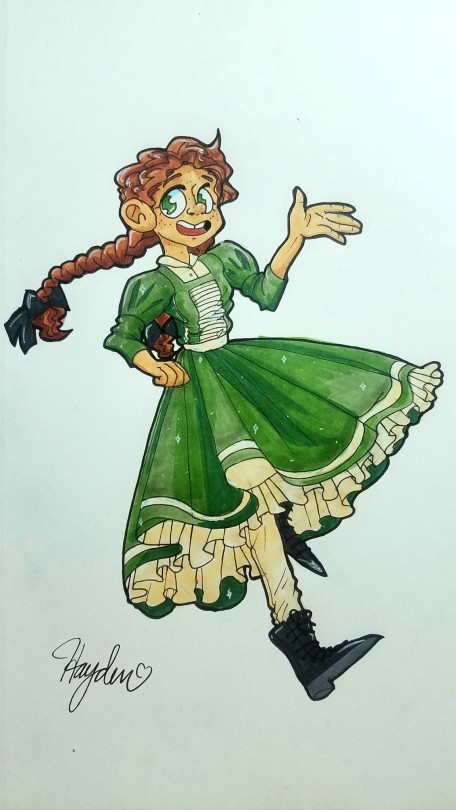I’m sure we’ve all come across pieces, or made pieces with the rainbow feature that just doesn’t look right. Something about the wide selection of colour and the way it’s implemented can really make or break a piece ( just like with any manner of pallette endeavours ).
The fact of the matter is that rainbows are incredibly temperemental, and it takes careful thought and consideration to implement them anywhere in a design. The huge spectrum of colour is an immediate attention stealer, and i personally would only use the rainbow for details or what i would consider a character’s defining trait, since its presence tends to hog the viewer’s focus.
I don’t typically use rainbows in my designs, mostly since i tend to dabble in much simpler pallettes as part of my style.
But while people tend to resent designs with rainbow pallettes involved, it is often not in due to the rainbow itself, it is due to the misuse of the pallette and stylization around it.
So let’s take a look at that two particular points.
Stylizing

There’s quite a few ways to incorporate rainbows into a design. I’m just going to present three, or the three most common i tend to see. These work pretty well within specific styles in my opinion, though typically, the softer the gradient fades from colour to colour through the rainbow, the better jives with simpler and heavily graphic styles ( A + B ). These highly simplified styles also allow us to suspend our sense of disbelief more, as the single direction of the gradients doesn’t break with the flow of any particular locks of hair ( as there is no locks of hair defined ).
Once you start moving into art styles that contents itself highly with the direction, volume and overall flow of the figure ( for an example detailed toony styles, or semi-realism ) you might be inclined to work with ‘C’, as it addresses the direction and volume of whatever object your drawing, and will adhere to the construction of your design much less intrusively.
The surrounding pallette

Now, as i mentioned before, as much as stylization of your rainbow can be intrusive stylistically - it is equally, if not more disruptive to any pre-established pallette that isn’t carefully tailored to it.
^Above, i’ve slapped a rainbow into the hair of my character design. Now, his skin-tone mixed with the white of his hair and the light in his irises makes it a little easier on the eyes. It’s not perfect, still pretty busy looking, but it’s not atrocious looking either.
However, when taking his outfit into consideration, the rainbow bit starts to stick out rather garishly. This could be because of the colours from the added rainbow is clashing with the somewhat intricate colours of his outfit, that don’t draw from any of the colours in his hair.

For inspiration, we can look to characters such as Rainbow dash from My Little Pony: Friendship is Magic. This character makes use of rainbows pretty extensively in the mane, the tail and the mark on her hindleg. This is all brought together and balanced out by a very simple basecolour - a slightly dulled baby blue.
This uniform colour only accompanied by a little sprinkle of pinkish-reds ensures that the pallette isn’t actively fighting the rainbow, and letting the rainbow take up the visual interest that it demands.
The important part about rainbows is to give them space in your pallette to breathe, and this is most easily achieved by using very neutral colours, and avoid incorporating too many other colourful details in your design.

So three no-no’s based on what we just learned.
1. Stick with somewhat desaturated colours that doesn’t compete with the saturation of your rainbow.
2. Avoid incorporating more colours than necessary, this way you won’t end up with a design that looks “busy” or “chaotic”.
3. Avoid complex, coloured patterns that could draw attention away from the rainbow.

Try instead:
1. Clean, desaturated whites, greys or blacks to accompany and frame your rainbow.
2. Remember that darker colours offers a very hard contrast that can add vibrancy to your rainbow.
3. If/when you incorporate other colours into your design, don’t make them too bright, i recommend keeping them a little dark and a little dull. My personal preference would be using blue-tones, but you can use any colour you like as long as they’re muted.

Ultimately, incorporating rainbows is a wild endeavour, and i’m not here to tell you what to do and what not to do, only give my two cents on how to solve the “garish” rainbow situation that can arise if you work with the full colour spectrum without knowing what you’re doing.
I think i’d like to boil it down to a matter of restraint ( and colour theory.
Something you can read more about in my post here:
https://theredlinestation.tumblr.com/post/185826075569/one-thing-i-really-struggle-with-is-color-picking )
Mod Em also did a bit on colours some time back:
https://theredlinestation.tumblr.com/post/181383173276/aah-okay-so-today-i-was-rendering-in-black-and
You can technically pull anything off, if you know how to make something work with the rules of colour theory, and knowing exactly how to bend the rules just right.
- Mod Wackart ( Ko-fi )
from The Redline Station https://ift.tt/2WrCXCi
via IFTTT

No comments:
Post a Comment